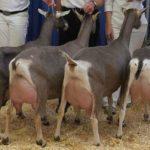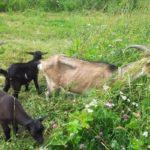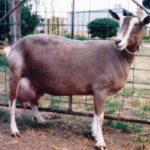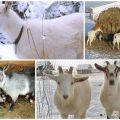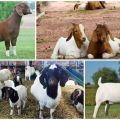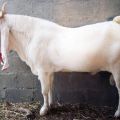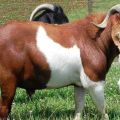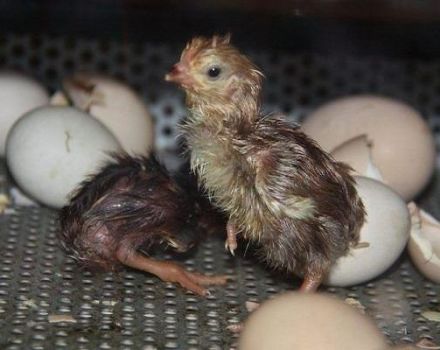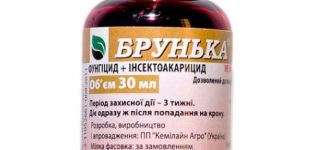Description and characteristics of Toggenburg goats, rules of keeping
The Toggenburg goat breed was bred several centuries ago. These animals are mainly bred in western Europe and the European part of Russia. These are dairy goats, giving about 5 liters of high-fat milk per day. Animals eat grass in summer and hay in winter. They tolerate severe winters well. True, in the cold season it is recommended to keep them indoors.
Origin of the Toggenburg goat breed
Animals of this breed belong to the Alpine dairy goats. They are bred mainly for the sake of obtaining milk. True, an adult animal weighing 50 kilograms gives about 25 kg of meat. They also have beautiful skins with an ash brownish coat. Toggenburg goats give 3-5 liters of milk with a fat content of 4-5% per day.
This breed was developed in Switzerland. It took several centuries before the Toggenburg goats were produced. The development of a new breed was carried out by ordinary farmers. They selected individuals with the highest productivity, giving the most milk. An improved dairy breed of characteristic color appeared in Toggenburg in the 18th century. Hence the name of these goats. In the 19th century, or rather in 1892, the Toggenburg breed was officially registered. These goats began to be bred for sale.
At the beginning of the 20th century, animals of this breed appeared in all countries of Western Europe, and even in the USA and Russia. Local farmers crossed them with domestic goats. Soon, new breeds appeared on the basis of the Toggenburg breed (English Toggenburg, Czech brown, German Thuringian forest and others). In Switzerland itself, the peak of the popularity of these goats came in the middle of the 20th century.
Currently, in the homeland of the Toggenburg breed, farmers breed other animals for milk. Saanen goats are more productive. In Russia, the Toggenburg breed was bred even before the revolution. Then they forgot about these goats and paid attention to them only after the collapse of the USSR. True, their livestock in modern Russia is still small.

Description and characteristics of the animal
The Toggenburg breed has an interesting color. The wool of these goats is short, but thick, ash-brownish. There are goats with chocolate and brown-black colors. They have a white spot under their tail. The head is dark. True, there are two white stripes on the sides of the muzzle. Ears - light at the edges, small, erect. Legs - wide apart, straight, also white towards the bottom. The goat has a small dark beard and a short tail. The Toggenburg breed has no horns.
The body of these animals is barrel-shaped, angular, gradually widening towards the rear. Height at withers - 65-75 cm, weight - 45-65 kg.The udder is large, with two nipples. Productivity per year - 700-1000 liters of milk. The goat is adapted to cold climates. It is milked all year round, even in winter. Milk taste and milk yield depend on the diet and conditions of detention. Animals feed mainly on grass and hay.
Main pros and cons
Advantages of the breed:
- good immunity;
- undemanding to feed;
- excellent adaptability to cold climates;
- year-round lactation;
- high milk yield;
- delicious milk from which you can make cheese.
Disadvantages of the Toggenburg breed:
- not suitable for meat breeding;
- gains weight slowly, but eats a lot of feed;
- to prolong lactation, females need to mate every year.
Breed conditions and care
The Toggenburg goats in their homeland in Switzerland grazed in the highlands, and due to the lack of pasture they could stand in the stall all year round. You need to keep these animals in the barn. In summer, they can graze in the meadow all day. In winter, animals should be kept in a warm room.
In the barn, the temperature is maintained at 10-20 degrees all year round. Be sure to install ventilation, windows and doors. At lower temperatures, animals will not milk well. In the heat, representatives of the Toggenburg breed often overheat, which is why milk yield falls. In the barn there should be a manger for hay, feeders for finely chopped vegetables and grains, a drinking bowl (bucket) for water.
In summer, goats can be driven out to the meadow in the morning, after the dew has subsided, but it is better for the animals to wait out the heat in a cool room. The barn should be dry and fresh. The bedding (straw) is changed every day. If representatives of the Toggenburg breed are kept in mud and damp, they will get sick. If the litter is not changed, then the animal will have problems with the udder.
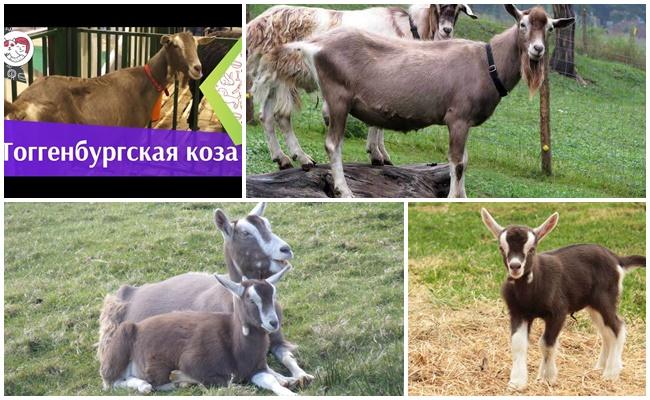
How to feed a goat
Animals are fed 2-3 times a day. In the summer, from morning to lunch, and in the afternoon, before sunset, they can graze in the meadow. It is good for goats to eat green grass and be outdoors. The most beneficial are cereals and legumes. Animals need to be fed with clover, alfalfa, timothy, fescue, nettle. They eat up to 8 kg of green grass per day. When goats graze in pasture, you need to make sure that they do not eat poisonous or soapy (with saponins) plants.
Additionally, animals can be fed with vegetables (pumpkin, carrots, beets), beet tops, branches of fruit bushes and trees.
In winter, the goats are fed with sun-dried hay. It must be prepared at least 500 kilograms for one individual. The animal is given about 4 kg of hay per day. In winter, goats are fed with root crops, grain mixtures (oats, corn, barley, wheat). In the cold period, the animals are given spruce branches, premixes, pharmaceutical vitamins and minerals, bone meal, chalk, and salt stone for licking.
In between feedings, goats are watered with clean water (5 liters of water per individual 2 times a day). The liquid can be slightly sweetened or salted. Do not water animals immediately after staying in the pasture. Lots of fresh herbs, especially legumes, plus drinking water can lead to bloating. It is advisable to ensure that the goats do not overeat. If animals graze greedily, you need to make them move a lot.
Breeding rules
Sexual maturity in the Toggenburg breed occurs at 6 months of age. True, it is recommended to cover females only at 12-18 months. A thoroughbred goat is selected for mating, then the offspring will be first-class. Cover the goat on hunting days. During pregnancy, females begin to grow udders. Colostrum appears 60-70 days after mating. Pregnancy lasts 5 months. 1-4 cubs are born. For the first 3 weeks, the kids should drink all the milk. When the cubs are a little older, milk can be donated little by little for personal use.
You need to cover the female once a year, not more often, preferably in the fall, so that the babies are born in the spring. Then the cubs born after milk feeding in the summer can be transferred to green grass, that is, to graze in the meadow. During the warm season, the kids will gain about 30 kg of weight and they can be slaughtered for meat or sold before wintering.
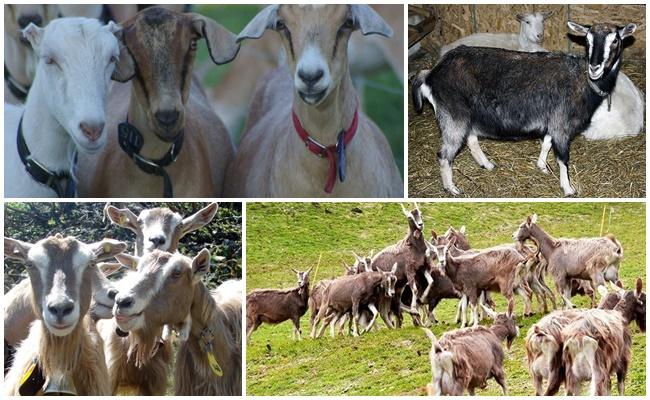
Frequent illnesses
Goats suffer from bloating if they graze in a meadow in the rain or in the morning through dew. In cold and damp weather, animals can get colds. With improper feeding, they develop gastrointestinal problems. An excess of grain leads to ketosis, a lack of vitamins and minerals affects the offspring (non-viable, weak).
If the animal is kept in a damp and cold room, it can develop rheumatism. Goats suffer from hoof inflammation if injured due to carelessness.
Young goats often develop mastitis with the appearance of milk. For this disease, animals are given to drink water with dill. Massage, rubbing the udder with camphor oil, unsalted fat, comfrey tincture on vodka, ichthyol ointment saves from mastitis. To protect against dangerous diseases, kids at the age of 3 months are vaccinated against anthrax, foot and mouth disease, brucellosis, rabies, tetanus, and parasites. Prevention of fleas and worms is carried out on a quarterly basis. The health of the Toggenburg breed is influenced by the conditions of keeping and the quality of the feed.
Prospects for breeding Toggenburg goats in Russia
Russian farmers know Toggenburg goats well. These animals are loved for their calm nature and high milk yield. After 3-4 lambing, a female can give up to 6 liters of milk per day. The peak of productivity occurs at 5-6 years of age. Such goats are kept for about 10 years, then replaced with young ones.
Animals of the Toggenburg breed adapt well to the climate of the middle zone, tolerate severe winters well. They are bred mainly in the Vologda, Kostroma and Leningrad regions. In Siberia and the Far East, the Toggenburg breed is rare. In these regions of Russia, there are no breeding animals for breeding, and it is not easy to get them.


